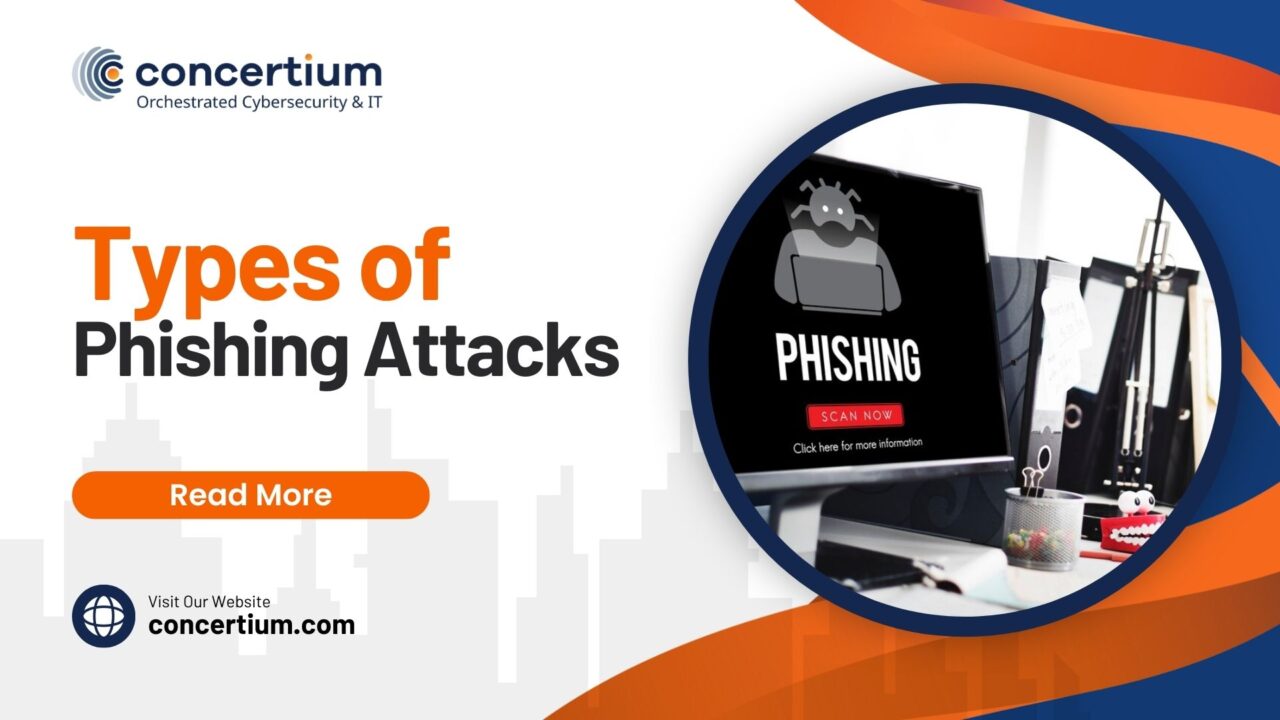Phishing attacks are deceptive techniques used by cybercriminals to trick individuals into revealing personal information or downloading malicious software. Awareness and prevention are crucial because these attacks exploit human psychology rather than technological weaknesses. Therefore, understanding the common types of phishing and how to avoid them is paramount in safeguarding one’s digital life.
In this blog post you’ll read a complete guide about different types of phishing attacks and how they work? Moreover, you’ll learn about how to prevent from these phishing attacks.
What are Phishing Attacks?
Phishing attacks are deceptive maneuvers by cybercriminals aiming to steal sensitive data like login credentials and credit card numbers. These attacks often take the form of emails, texts, or phone calls that masquerade as reputable entities such as banks or government agencies. Attackers lure individuals into providing personal information by creating a sense of urgency or fear.

To protect against phishing, it’s crucial to verify the authenticity of messages, avoid clicking on suspicious links, and employ robust cybersecurity measures. Awareness and education on recognizing these fraudulent attempts are key defenses in safeguarding personal and organizational data against the evolving tactics of phishing scams.
9 Types of Phishing Attacks
Email Phishing
Email phishing is a widespread type of phishing attack where criminals send fraudulent emails. These emails mimic legitimate communications, aiming to trick the recipient into clicking a malicious link or downloading an attachment. For instance, you might receive an email that appears to be from your bank, urging you to verify your account details. However, the link leads to a fake website designed to steal your information.
Prevention tips include scrutinizing email addresses and links for subtle inconsistencies. In addition, organizations like the Cybersecurity & Infrastructure Security Agency (CISA) offer resources on phishing protection. Above all, never click a link or download an attachment from an unsolicited email, no matter how genuine it seems.
Spear Phishing
Spear phishing is a more sophisticated type of phishing attack. Unlike general email phishing, spear phishing targets specific individuals or organizations. Cybercriminals gather personal details about their target to craft a convincing message, often leading to a higher success rate.
For individuals, the best countermeasure is security awareness training. Organizations should also implement strict email filters and verification processes to detect spear phishing emails. The Federal Trade Commission provides additional insights on recognizing and avoiding these scams.
Whaling
Whaling attacks focus on “big fish,” such as executives or high-ranking officials within an organization. These types of phishing attacks are crafted to appear as critical business communications, tricking the target into authorizing financial transactions or revealing sensitive data.
To protect against whaling, executives should undergo advanced security awareness training, emphasizing the nuances of targeted phishing campaigns. Organizations must also adopt multi-factor authentication and establish a protocol for verifying the authenticity of requests involving sensitive information or financial decisions.
Smishing and Vishing
Smishing and vishing are phishing attacks sent via text message and voice calls, respectively. These tactics leverage the personal nature of phones to trick individuals into divulging sensitive information. Smishing might involve an SMS phishing alert from a seemingly reputable source, urging you to click a link. Vishing, on the other hand, uses a direct phone call to solicit personal details directly.
To avoid these attacks, always be skeptical of unsolicited requests for personal information, whether through a call or SMS. For instance, a bank will never ask for your password over the phone. In addition, look out for signs of phishing like urgency or threats in the message’s tone. Above all, if you receive a suspicious call or message, contact the institution directly using a verified number to verify the communication’s legitimacy.
Angler Phishing
Angler phishing is a relatively new type of attack that uses social media to masquerade as customer service accounts. These fake accounts often reach out to individuals who have posted about issues with a service, offering “help” that involves handing over personal details or clicking malicious links.
Maintaining security on social platforms involves a healthy dose of skepticism. Verify the authenticity of any account claiming to offer support by checking its history and official affiliation.
Clone Phishing
Clone phishing involves creating a nearly identical copy of a legitimate email, complete with malicious links or attachments. This type of phishing attack preys on the recipient’s trust in the sender, making it particularly insidious.
Detecting clone phishing requires a keen eye for detail. Look out for subtle discrepancies in the sender’s email address or the email’s language. If an email seems out of character or requests unusual actions, verify its authenticity by contacting the sender through a different channel. Email security measures, such as using email filters and regularly updating passwords, can also mitigate the risk of clone phishing.
In all these scenarios, the key to prevention lies in vigilance and education. By understanding the different types of phishing attacks, individuals and organizations can better protect themselves against these ever-evolving threats.
Pharming
Pharming stands as a type of phishing attack where cybercriminals manipulate the Domain Name System (DNS) to redirect users from legitimate websites to fraudulent ones without their knowledge. This technique can capture personal information or distribute malware.
Ensuring network security against pharming involves regularly updating your DNS settings and using secured protocols like HTTPS. Moreover, installing anti-phishing toolbars and antivirus software with real-time protection can help detect and block suspicious activities. Above all, awareness and caution when entering personal details online are paramount.
Snowshoeing Attack
A snowshoeing attack is a sophisticated phishing technique where cybercriminals distribute spam or phishing emails across a wide range of IP addresses and domains at a low volume. This method helps the attack evade detection by spreading out the attack’s footprint, much like a snowshoe spreads out the weight to walk on snow without sinking.
The aim is to trick recipients into divulging personal information or clicking on malicious links by making the emails appear legitimate and bypassing spam filters.
To protect against snowshoeing attacks, individuals and organizations should employ advanced spam filters, regularly update security protocols, and educate users on the importance of scrutinizing emails from unfamiliar sources.
Watering Hole Attack
A watering hole attack is a targeted phishing strategy where cybercriminals infect websites known to be visited by their intended victims with malware. The attackers compromise a legitimate site to distribute malware automatically to visitors, exploiting vulnerabilities in their browsers or other software.
The goal is to gain unauthorized access to the victim’s network or steal sensitive data. These attacks are particularly insidious as they exploit the trust users have in legitimate websites.
Protecting against watering hole attacks requires keeping software and security patches up to date, employing web filters to block known malicious sites, and conducting regular security awareness training to recognize and avoid suspicious website activity.
By staying informed about these phishing techniques and implementing robust preventative measures, individuals and organizations can significantly reduce their risk of falling victim to these deceptive practices.
How to Prevent Phishing Attacks
Preventing phishing attacks requires a multi-faceted approach. First and foremost, security awareness training can empower individuals to recognize and avoid phishing attempts. For instance, verifying the authenticity of emails and messages before responding or clicking on links is crucial. Similarly, scrutinizing email addresses and looking for signs of phishing emails, such as poor spelling and grammar, can help identify malicious intent.
Moreover, employing advanced email security solutions that can detect and quarantine phishing attempts is vital for organizations. Implementing two-factor authentication (2FA) adds an additional layer of security, making it harder for attackers to gain unauthorized access even if they manage to obtain personal details.
In addition, keeping software up to date and using firewalls can protect against various types of phishing attacks, including those that exploit software vulnerabilities. The Federal Trade Commission’s Consumer Information on Phishing offers valuable resources on identifying and avoiding phishing scams.
What People Also Ask
What is phishing and how does it work?
Phishing is a cyber type of attack where attackers masquerade as trustworthy entities to steal sensitive data. They use emails, text messages, or phone calls to trick recipients into revealing personal information.
How can I identify a phishing email or message?
Look for urgent language, misspellings, and unfamiliar sender addresses. Authentic organizations rarely request sensitive information via email or SMS message.
What should I do if I fall victim to a phishing attack?
Change your passwords immediately and alert the affected institutions. Reporting the attack to authorities can also help mitigate its impact.
Are there any tools or services that can help protect against phishing?
Yes, there are numerous anti-phishing tools and services available. They range from browser extensions that alert users to malicious websites to email filtering services that detect phishing attempts.
Conclusion
In conclusion, phishing attacks, leveraging tactics from social engineering to sophisticated voice phishing, pose a significant threat to both individuals and businesses. Common phishing schemes, including business email compromise and deceptive emails, aim to exploit human psychology for unauthorized access to personal data, leading to potential data breaches. It’s imperative to stay vigilant, educate oneself on the hallmarks of these scams, and implement robust security measures to protect email accounts and sensitive information.
By fostering an environment of awareness and adopting proactive defense strategies, we can mitigate the risks associated with these cyber threats and safeguard our digital lives against the ever-evolving landscape of cyber fraud.





